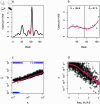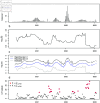Time-series modeling of epidemics in complex populations: Detecting changes in incidence volatility over time
- PMID: 40644513
- PMCID: PMC12266409
- DOI: 10.1371/journal.pcbi.1012882
Time-series modeling of epidemics in complex populations: Detecting changes in incidence volatility over time
Abstract
Trends in infectious disease incidence provide important information about epidemic dynamics and prospects for control. Higher-frequency variation around incidence trends can shed light on the processes driving epidemics in complex populations, as transmission heterogeneity, shifting landscapes of susceptibility, and fluctuations in reporting can impact the volatility of observed case counts. However, measures of temporal volatility in incidence, and how volatility changes over time, are often overlooked in population-level analyses of incidence data, which typically focus on moving averages. Here we present a statistical framework to quantify temporal changes in incidence dispersion and to detect rapid shifts in the dispersion parameter, which may signal new epidemic phases. We apply the method to COVID-19 incidence data in 144 United States (US) counties from January 1st, 2020 to March 23rd, 2023. Theory predicts that dispersion should be inversely proportional to incidence, however our method reveals pronounced temporal trends in dispersion that are not explained by incidence alone, but which are replicated across counties. In particular, dispersion increased around the major surge in cases in 2022, and highly overdispersed patterns became more frequent later in the time series. These increases potentially indicate transmission heterogeneity, changes in the susceptibility landscape, or that there were changes in reporting. Shifts in dispersion can also indicate shifts in epidemic phase, so our method provides a way for public health officials to anticipate and manage changes in epidemic regime and the drivers of transmission.
Copyright: © 2025 Aber et al. This is an open access article distributed under the terms of the Creative Commons Attribution License, which permits unrestricted use, distribution, and reproduction in any medium, provided the original author and source are credited.
Conflict of interest statement
The authors have declared that no competing interests exist.
Figures



References
MeSH terms
LinkOut - more resources
Full Text Sources
Medical

